#Global Maritime News
Explore tagged Tumblr posts
Text
The Revolutionary Impact of the Compass: Navigating the World with Precision and Vision
https://gob.stayingalive.in/revving-up-knowledge-unveil/the-revolutionary-impact-of.html Discover how the invention of the compass revolutionized navigation, enhancing global exploration, and trade, and connecting distant lands with precision. The Compass: The modern compass, as a navigational tool, has a long history and its development spans different cultures. The earliest known discovery…
#ancient navigation#compass and GPS#compass history#compass in exploration#compass invention#compass revolution#exploration tools#global trade and navigation#Good Old Bandit#Gud Ol&039; Bandit#impact of the compass#maritime trade#modern navigation technology#navigation technology evolution#News#role of the compass#Sanjay K Mohindroo#Sanjay Kumar Mohindroo#Sanjay Mohindroo#trade routes#world discovery
0 notes
Text
Challenge: Integrated Central Information System (ICIS) for Maritime Operations - Technology Org
New Post has been published on https://thedigitalinsider.com/challenge-integrated-central-information-system-icis-for-maritime-operations-technology-org/
Challenge: Integrated Central Information System (ICIS) for Maritime Operations - Technology Org


NineSigma, representing QRDI / Milaha International LLC (“QRDI / Milaha”), invites participants to submit proposals to design and construct a next-generation harbour craft prize challenge.
QRDI / Milaha believes that using HDPE in ship design and construction will provide opportunities for electrification and enhance the overall sustainability of the global shipping industry. In general, construction time would be reduced, allowing design flexibility and scalability.
The Seeker invites participants with a proven track record and experience in HDPE ship design and construction to submit proposals for transferring technology to a local shipyard to design and construct the next generation of harbour craft in Qatar.
Submissions to this Challenge must be received by May 23, 2024.
Source: NineSight
You can offer your link to a page which is relevant to the topic of this post.
#2024#challenge#Competitions#construction#craft#Design#electrification#Energy & fuel news#Global#HDPE#Industry#Link#maritime#shipping#sustainability#technology#time
0 notes
Text
There is some CONFUSION about the Armed Forces of the Philippines’ (AFP) Participation in the United States (US)-Japan-Australia Joint Naval Drills in the SCS, US could be trying to SHAME the AFP into joining it
#philippines#china#united states us#ayungin shoal#armed forces of the philippines afp#south china sea scs#japan#australia#kyodo+ news agency#chinese communist party ccp#the global times#romeo brawner junior#uss america lha-6#united states navy usn#js izumo ddh-183#japan maritime self defense force jmsdf#hmas canberra l02#royal australian navy ran
0 notes
Text
Symbolism of Poseidon
🌊🔱🌊🔱🌊🔱🌊🔱🌊🔱🌊🔱🌊🔱🌊
One of the most severely under-respected gods in my opinion, Poseidon is the fearsome, ruthless, yet incredibly fatherly god of the oceans and the Maritime. He controls the oceans, brings bounties of fish to the anglers, and can protect or claim sailors of the seas. He is a father to many the young gods and goddesses, a particular ally of young virgin Artemis and her brother Apollo, protecting them from the wrath of Zeus through several tales of the Greek Mythos, as well as the father figure of beautiful Aphrodite, who came form his sea foam. Many things can be associated with him, so let’s take a look at some of the symbols of king Poseidon, shall we?
• 🐚 seashells and ocean curios: as the god of the seas, it’s no wonder that shells, scales, pearls, coral, and other ocean curiosities are timeless symbols of the king Poseidon. Many an altar dedicated to his might is peppered with spiraling and intricate shells, coral branches, and other ocean treasures!
• 🌊 Waves and seafoam: the story of Aphrodite is inherently, if not directly, connected to that of Poseidon’s. It was from his domain she was born of sea-foam, and their relationship would ultimately end in an affair later on in her story. Sea-foam is now widely associated with both her and king Poseidon, and waves are also connected to the two, often felt lapping at our feet as a symbol of love, in different forms from the two gods linked to it.
• 🐬 animals: it should come as no surprise that the vast number of creatures that paint the seas are all the epithets of Poseidon, from dolphins, to crabs, to octopus, the animals of the ocean blue are all symbolic of his domain and power. Some of the more well known are the dolphin, whom Poseidon used as messengers to deliver his word, and whom often followed him. Another is the seahorse, it is said the king created the odd little creature by combining the body of a horse with that of a fish, and that his chariot was led by four mighty seahorses!
• 🦪 foods: several foods can be attributed to Poseidon, after-all, the ocean, one of the biggest sources of food globally, is apart of his domain. Oysters, sushi, lobster, are all emblemic of the plethoric abundance his domain offers hungry humans willing to brave its tides!
• 💎 gemstones: a common theme with king Poseidon is that his domain truly does reflect him, and his symbolism is inherently connected to him. A few great examples of this are Larimar, a bright blue gemstone that resembles the sea and is named after dolphins, an important epiphet of the god. or aquamarine, a stone that in Ancient Greece was believed to be a talisman sent by Poseidon to shield sailors from the wrath of the sea! Pearls are also a safe bet, nothing is more representative of the wealth and prestige of the ocean than a pearl!
• 🔱 Other symbols: Poseidon’s symbols are widespread in many forms through green mythology, tridents are his infamous weapon of choice, a powerful tool wielded by the king of the ocean, as is lightning, a powerful energy he shares with Zeus.
🌊🔱🌊🔱🌊🔱🌊🔱🌊🔱🌊🔱🌊🔱🌊
Did you learn something new about king Poseidon? Let me know, and tell me how you worship him!
#male witch#green witch#hellenism#paganism#witchcraft#druidism#hellenic worship#baby witch#sea witch#poseidon devotion#poseidon deity#poseidon worship#poseidon#king poseidon#poseidon devotee
75 notes
·
View notes
Text
Another any time sensitive scenario was the Supreme Court’s expected announcement of their decision on the Brunson case. That case simply asked if Congress investigated allegations of voter fraud during the 2020 Election, which they did not. A positive SCOTUS decision would overturn the 2020 Election and bring down the Biden Administration, plus all of Congress.
The Military would then take over until a new election could be held. However, the Military accounting of watermarked ballots of the 2020 Election substantiated that Trump actually won that election by an over 80% vote in every state but one. Thus, it was possible that the Military could install Trump as the duly elected US President.
The Make America Great Again Trump was badly needed. A pending Nuclear World War III could be averted upon installation of a Global Currency Reset. There were 209 nations which had already signed an agreement that they would not be at war so they could participate in the new Global Financial System.
Activation of the GCR & GESARA/NESARA Law would then return all Taxpayer Dollars to The People instead of being paid to the Cabal which had stolen that money since the early 1900s.
Another agreement of the 209 Sovereign nations which wanted to participate in the new Global Financial System, was that they would install principles of the Original 1776 Constitution in their governments, and pay for Med Bed treatments for their people that would restore and maintain their health.
As you can see the top three branches of the government have been corrupted and it has to be done by the rule of law, not maritime law but natural and constitutional law. Otherwise it's just more crimes being committed by different people. The criminals at work won't just surrender because they know what they have done and the punishment for treason, war crimes and crimes against humanity is death after a military tribunal. 🤔
#pay attention#educate yourselves#educate yourself#knowledge is power#reeducate yourselves#reeducate yourself#think about it#think for yourselves#think for yourself#do your homework#do your own research#do some research#do your research#ask yourself questions#question everything#government corruption#news#the future#it's coming#be patient
66 notes
·
View notes
Text

𝗛𝗼𝗹𝗱 𝘁𝗵𝗲 𝗨𝗦 𝗔𝗰𝗰𝗼𝘂𝗻𝘁𝗮𝗯𝗹𝗲 𝗳𝗼𝗿 𝗜𝘁𝘀 𝗖𝗼𝘃𝗲𝗿𝘁 𝗙𝗮𝗸𝗲 𝗡𝗲𝘄𝘀 𝗢𝗽𝗲𝗿𝗮𝘁𝗶𝗼𝗻 𝗶𝗻 𝘁𝗵𝗲 𝗣𝗵𝗶𝗹𝗶𝗽𝗽𝗶𝗻𝗲𝘀
On June 14, 2024, international news agency Reuters exposed a secret disinformation campaign by the US Department of State meant to discredit Chinese-manufactured COVID-19 vaccines amongst Filipinos. The US anti-vax fake news campaign ran from 2020 to 2021, and involved the use of dummy social media accounts posting false and unscientific information about the efficacy of Chinese vaccines, as well as weaponizing pervasive racist conspiracy theories that the COVID-19 pandemic was created and spread by the Chinese government.
We demand an immediate investigation by the Philippine government on the matter, and for decisive action to be taken by the government to hold the US accountable for its deception campaign against the Filipino people. The Reuters exposé has uncovered a clear national security threat to the Filipino people. The US carried out its fake news campaign at a time when the COVID-19 pandemic was ravaging the Filipino people, and worsened already widespread anti-vaccination beliefs amongst the public.
We are appalled by the glaring lack of Philippine media coverage on the Reuters exposé. An international scandal has just been uncovered. How can truth be spoken to power, and how can political action be taken by citizens, if the media does not play its part? Silence is silence, whether due to the threat of repression or the suffocating consensus by media capitalists that unsavory things be left unsaid. We call on all media workers, whether working at mainstream media organizations, independent media, social media, or campus media, to take the lead themselves and focus public attention on this issue.
The year-long campaign clearly demonstrates the untrustworthiness of the US as a strategic diplomatic and military partner of the Philippines and of all Global South countries. The campaign was initiated by the Trump administration and was first focused on the Philippines. Later on, the project was expanded further into Central Asia and the Middle East. It took the Biden administration three full months to end the globalized and state-sponsored mass disinformation project.
This issue is not just a problem of specific administrations. The year-long campaign should remind the workers and the masses of the Philippines and the world that the US remains the world’s foremost imperialist power. Its overriding foreign policy concern is the maintenance of its dominant global military and economic position, and its means are deception and force.
The US’ covert effort to corrupt public discourse in the Philippines should prompt the Marcos administration to question the intentions of its close diplomatic and military ally. The disinformation campaign was motivated primarily by the US’ geopolitical rivalry with China, which has, since the former’s Pivot to Asia in 2012, increasingly taken on a more militarized and antagonistic form. US military and intelligence agencies are manufacturing consent in the Philippines to win the hearts and minds of the Filipino masses in its effort to overpower China through military means. This is its real goal, and not to aid the Filipino people to address Chinese maritime aggression.
The US has no legitimacy to pose as a champion of international laws and norms and as a partner to secure the Philippines’ national sovereignty. It conducted its campaign to serve its own geopolitical interests with no regard for the immense need of the Philippines to vaccinate its citizens against the pandemic. Once again, Washington D.C. has Filipino blood on its hands.
US interference in Philippine public life cannot be left without consequences. Philippine foreign policy should pivot away from its longstanding reliance on the US and towards ASEAN, and away from addressing Chinese aggression through militarized means and towards regional multilateral diplomacy. 𝙏𝙝𝙚 𝙥𝙚𝙖𝙘𝙚 𝙖𝙣𝙙 𝙨𝙤𝙫𝙚𝙧𝙚𝙞𝙜𝙣𝙩𝙮 𝙤𝙛 𝙩𝙝𝙚 𝙋𝙝𝙞𝙡𝙞𝙥𝙥𝙞𝙣𝙚𝙨 𝙘𝙖𝙣 𝙤𝙣𝙡𝙮 𝙗𝙚 𝙜𝙪𝙖𝙧𝙖𝙣𝙩𝙚𝙚𝙙 𝙗𝙮 𝙩𝙝𝙚 𝙁𝙞𝙡𝙞𝙥𝙞𝙣𝙤 𝙢𝙖𝙨𝙨𝙚𝙨. 𝙄𝙢𝙥𝙚𝙧𝙞𝙖𝙡𝙞𝙨𝙩𝙨 𝙖𝙧𝙚 𝙣𝙤 𝙛𝙧𝙞𝙚𝙣𝙙𝙨 𝙤𝙛 𝙤𝙪𝙧𝙨!
📷 AP
Reposted from SPARK - Samahan ng Progresibong Kabataan (Union of Progressive Youth), a socialist youth organization in the Philippines.
68 notes
·
View notes
Text
Sorry to bring back up the Titan submersible, but I find it fascinating in a very morbid way. Mostly in terms of the news. This will be the media student in me talking but to me, it’s a perfect example of so many of Galtung and Ruge’s news values. I’ll also be looking at the migrant boat that sunk off the coast of Greece for similar comparison and why an American centric website would probably see more news relating to the submersible.
Put simply, one of Galtung and Ruge’s news values is proximity, aka how close to home it was and how meaningful it is to the people there. Since the submersible launched from Newfoundland, Canada would’ve gotten more news stories about the submersible. Meanwhile, the boat with the immigrants was found off the coast of Greece, with more stories about it there. Since the USA is closer to Canada than Greece, they got more stories about the sub than the boat.
Another value is currency. This is why me, a Brit, got more news coverage on the boat for the first few days. The UK has a known immigration problem and some really dodgy laws about it (basically in most circumstances you can only apply for a permit once you’re in the country but entering the country without a permit is illegal, so it’s a catch 22), so something about immigration would always be more relevant. However, the antithesis recency would affect how in the last few hours of the sub being missing when the air was thought to be running out (so morning and afternoon of 22nd June) there were more stories on the sub.
A fourth value is uniqueness. Sadly, a migrant ship sinking with people dying and going missing is not an uncommon thing nowadays. A maritime disaster involving billionaires touring the Titanic? Never happened before, I hope it will never happen again (and it most likely will not). Of course the news will focus on something that hasn’t happened before - when will they get the chance to do it?
There’s also the values of Elite People. These people were billionaires. The people on the migrant ship were most likely just normal unnoteworthy people. And also recency - the Messenia boat occurred in the 14th June, and by the time the debris of the boat had been discovered it has already been a week.
I think it is important we take these news values into consideration and also how we as a community on Tumblr can see how we played right into these. An American website with a large American usership would naturally gravitate towards an American story, no matter how global it claims to be. In addition, it’s unusual enough with such strange circumstances that jokes and criticisms were bound to occur. The continuity (another news value) of the story with the search was also intriguing, as we saw it play out first hand with the initial disappearance, the potential signals, the discovery of the wreckage. Add in a level of expectedness (another news value - these people would either be found or not, and let’s be honest they were more likely to be dead than alive) and we have a perfectly newsworthy story to top the trending page for a few days.
It’s something I find fascinating, how despite people saying we should focus on the Messenia migrant boat disaster, we were still echoing the news perfectly on the site. One thing I’ve noted is that I didn’t really see anybody mentioning it before the Titan set out, but once the searching started it started becoming more relevant and trending a little below it. This isn’t a call to do better, this is just something I’ve noticed.
If there’s any saving light, out of the estimated 750 (maximum) of migrants, 104 have been confirmed alive and rescued. And I’m so happy for that.
#con(versation)#greece#migrants#titanic#titan submersible#news values#galtung and ruge#seriously though tumblr look into news values if you want to know what we consume in the news#anyway it’s all old news now there’s a coup in russia
369 notes
·
View notes
Text
Okay, following up on that news I saw earlier. I first was alerted to it by the BBC Global News Podcast and Al Jazeera News Updates. For easier reference and more detail, however, I will be referring to this article from AP News for details, which itself references this article that cites the Washington Post.
Things of note:
This seems to have been caused by the recent incident where over 115 Palestinians were killed, and over 750 injured, by the IDF during a reported stampede by starving civilians trying to get to aid trucks.
The air drops will begin "in the coming days," and will start with MREs (military rations).
There will be multiple rounds, according to John Kirby.
The process will be done in conjunction with Jordan, which shares the longest of Israel's borders, the Eastern. (That part isn't in the article but I don't know how many people actually know where Jordan is.)
The US admits that it doesn't... know what it's doing? And is basically going to learn on the job. Not super promising but better than nothing. Most of the concern seems to be that the extreme crowding will increase the risk of injury; I assume dropping large pallets of supplies is easier when there's a lot of empty space, and smaller, less dangerous packages mean dropping less at a time since more space is needed in the planes for the parachutes.
Planes airdropping supplies is in itself MUCH LESS efficient than truck deliveries for this reason.
They're also hoping to set up a "maritime corridor" but there's no real word on how that's going to be achieved other than the ceasefire talks.
The U.S. has been pushing Israel to speed the flow of humanitarian assistance into Gaza and to open a third crossing into the territory, but Friday’s violence showed the challenges no matter the circumstances. “The loss of life is heartbreaking,” Biden said Friday as he announced his decision to order airdrops. “People are so desperate.”
Additionally, the second article has more details on the concerns that kept airdrops from being implemented earlier:
“Aid flowing to Gaza is nowhere nearly enough,” Biden said. “Now, it’s nowhere nearly enough. Innocent lives are on the line and children’s lives are on the line. We won’t stand by until we get more aid in there. We should be getting hundreds of trucks in, not just several.” The White House, State Department and Pentagon had been weighing the merits of U.S. military airdrops of assistance for several months, but had held off due to concerns that the method is inefficient, has no way of ensuring the aid gets to civilians in need and cannot make up for overland aid deliveries. [...] “It’s not the kind of thing you want to do in a heartbeat. you want to think it through carefully,” Kirby said. He added, “There’s few military operations that are more complicated than humanitarian assistance airdrops”
The second article also discusses how domestic conflicts, namely Speaker Johnson's refusal to address foreign crises until "taking care of America's needs" (paraphrase), have been delaying much of what could have been done before now.
#united states#gaza#israel#palestine#jordan#middle east#Joe Biden#John Kirby#death mention#aid#food aid#phoenix politics#current events
60 notes
·
View notes
Text
How do you solve a problem like the Houthis?
The U.S. Navy has certainly tried. It’s fired missiles at the militia’s facilities in Yemen. Together with the British Royal Navy, it has intercepted Houthi missiles being fired at ships in the Red Sea. All sorts of Western navies are conducting patrols in the troubled waters. But the Houthis are not relenting. On the contrary, they have asked the world’s most notorious arms dealer for more weapons. And the arrival of Russia’s Viktor Bout in the Red Sea is bad news for global shipping.
The Houthis are unlike any other adversary that Western militaries have faced in the past few decades. They’re not traditional armed forces. They’re not a Taliban-like insurgency outfit whose only objective is to seize territorial power. And they’re definitely not a mere criminal gang, like Somalia’s pirates.
Instead, the group is a powerful militia that has discovered that it can attack ships to get global attention, and it uses weapons ordinarily reserved for official armed forces.
Not even Hezbollah has such capabilities—or at least, it doesn’t use them, perhaps because Lebanon depends on shipping for its survival. Since the Houthis launched their campaign against Western-linked vessels, they’ve certainly been getting the attention they crave, and they’ve been demonstrating that they have access to highly sophisticated weaponry.
On Oct. 10, for example, the Yemeni outfit struck a Liberian-flagged ship with drones and missiles, and less than a month before that, they fired a missile that reached central Israel before being disabled by an Israeli interceptor.
The Houthis claimed the missile they directed at Israel was hypersonic, which has not been confirmed and is unlikely, but they like to brag. Their attacks seem designed to keep the global public in a state of fear over what might come next. And now, the Wall Street Journal reports, the group is in talks with Viktor Bout over the delivery of additional weapons.
Bout, you may remember, is the world’s most notorious arms dealer. The Russian merchant—who is known as the “merchant of death” and has also worked for Russia’s GRU intelligence service—spent nearly two decades selling weapons to armed groups around the world. Death and destruction followed wherever his weapons went.
But in 2008, the U.S. Drug Enforcement Administration (DEA) managed to get him arrested in a sting operation in Thailand. He was subsequently extradited to the United States and sentenced to 25 years in prison on several counts, including conspiracy to kill Americans.
“He’s one of the most dangerous men on the face of the earth,” Michael Braun—the DEA’s chief of operations until 2008—told CBS’s 60 Minutes in 2010.
But two years ago, the United States decided to trade Bout for an American citizen imprisoned in Russia, basketballer Brittney Griner. Former DEA officials were aghast. So were U.S. military personnel, who had seen the immense harm that Bout’s weapons were doing.
Writing in Foreign Policy, Braun strongly advised against the exchange, noting that Bout remained close to the Kremlin: “Even after formally leaving the GRU, Bout enjoyed the backing of—and at times took assignments from—his former employer.” But the Biden administration believed, or wanted to believe, that the Bout of 2022 was much less dangerous than the Bout of 2008.
And now the Houthis have turned to the wily arms dealer. Before his arrest one-and-a-half decades ago, he specialized AK-47s and grenade launchers, but he seems to be able to deliver whatever his clients need.
In 2008, he offered two FARC guerrillas who’d arranged to meet him in Thailand 30,000 AK-47s, “10 million rounds of ammunition, or more, five tons of C-4 plastic explosives, ultralight airplanes outfitted with grenade launchers, mortars, unmanned aerial vehicles, Dragunov sniper rifles with night vision, vehicle-mounted anti-aircraft cannons that could take down an airliner,” not to mention some 700 to 800 MANPADs (man-portable air-defense systems), as Politico subsequently reported. (Alas for Bout, the guerillas had been turned by the DEA, and Bout was arrested.)
That means that Western navies and shipping companies have to prepare for the potential arrival of new weaponry in the Red Sea. The first two deliveries facilitated by Bout, expected as early as this month, “will be mostly AK-74s, an upgraded version of the AK-47 assault rifle,” the Wall Street Journal reported in early October. Bout and the Houthis have also discussed Kornet anti-tank missiles and anti-aircraft weapons.
The Houthis may well need automatic assault rifles in their armed conflict against Yemen’s official government, but it’s the larger weapons that Western countries should worry most about. If Bout’s relationship with the Houthis takes off, anti-ship weapons could well follow. Thanks to Iran, the Houthis already have access to drones and missiles, but Iran is weakened and may not be able to focus much on the Houthis. That’s where Bout could be useful.
And the arms dealer’s talks with the Houthis are hardly a freelance venture. Since his return from a U.S. prison, Bout—hailed as a hero by Russian state media—has entered the warm embrace of the Russian state, and in last year’s regional elections, he was elected a member of the Ulyanovsk state parliament. If he procures weapons for the Houthis, it will be with the knowledge or even assistance of the Kremlin.
The Kremlin has already shown a desire to help the Houthis. Iran is brokering talks between Russia and the militia that would see Russian P-800 Oniks anti-ship missiles delivered to the Houthis, Reuters reported in September.
The powerful missiles, which have a range of 300 kilometers (186 miles) and carry a 200-kilogram (440 pound) high-explosive warhead, would significantly increase the risk for merchant vessels in the Red Sea—and even for the Western naval vessels there to protect them. Indeed, the arrival of the nasty P-800 Oniks would trigger the departure of the remaining few shipping companies still sending their vessels through the Red Sea.
“The very notion of the high seas is now challenged, and once state and/or nonstate actors, especially proxies, discover a new approach that has strategic, operational, and tactical impact, it will only be mimicked by others,” retired Vice Adm. Duncan Potts, who commanded the European Union’s counter-piracy operation in the Indian Ocean at the height of the piracy resurgence there in the early 2010s, told Foreign Policy. “I fear this is a game-changer,” he added. “Defending against complex weapons needs complex weapons, and there are relatively few navies who have the capability, number of platforms, and will to do anything about it.”
It’s also about the dividing world. Ever since launching its campaign against shipping last November, the Yemeni militia has spared Russian and Chinese vessels. The two powers have shown their appreciation by not pressuring the Houthis to end their campaign and—unlike earlier operations against Red Sea pirates, where China participated—by not taking part in escort plans. (Western countries are conducting the escorts and fighting of Houthi attacks regardless of what flag ships fly and in which country they’re owned.)
The fact that Moscow appears so willing to fund an assault on Western vessels shows that global shipping is splitting in two—and a divided ocean will be a far riskier and more costly place.
16 notes
·
View notes
Text
The past five months have shattered global temperature records, taking scientists by surprise. Many are asking why. A new study published in Oxford Open Climate Change, led by renowned U.S. climate scientist James Hansen, suggests one of the main drivers has been an unintentional global geoengineering experiment: the reduction of ship tracks. As commercial ships move across the ocean, they emit exhaust that includes sulfur. This can contribute to the formation of marine clouds through aerosols — also known as ship tracks — which radiate heat back out into space. However, in 2020, as part of an effort to curb the harmful aerosol pollution released by these ships, the International Maritime Organization (IMO) imposed strict regulations on shipping, reducing sulfur content in fuel from 3.5 per cent to 0.5 per cent. The reduction in marine clouds has allowed more heat to be absorbed into the oceans, accelerating an energy imbalance, where more heat is being trapped than being released.
Continue Reading.
134 notes
·
View notes
Text
The Overview
Art & Culture
Environmental Justice
Ethical Fashion
Identity & Community
All Topics
Shop
Support Us
Magazine
Newsletters
Contributors
About
For Black Archaeologists, the Atlantic Ocean is an Ancestral Graveyard
08.26.2024
WORDS BY OMNIA SAED
Photographs by Vanessa Diaz and Caroline Castro
Black maritime archeologists like Gabrielle Miller find both healing and terror as they excavate shipwrecks from the transatlantic slave trade.
At the end of this sentence, rain will begin. — Derek Walcott, Map of the New World
At a YMCA in Tulsa, Oklahoma, Gabrielle Miller plunges into a pool. While the swimmers around her float to the surface, she lets herself sink. She descends two feet, then six, then 12, until the tips of her toes graze the bottom. And there, she stands.
“It feels like I’m being wrapped, like a weighted blanket,” she said. “In that space, nothing else exists—no problems, no anxieties, not even time.”
The 31-year-old diver and maritime archaeologist is part of the Slave Wrecks Project, a Smithsonian effort to study the global slave trade by excavating sunken slave ships.
In the water, said Miller, “I see portals.”
The effort, hosted by the National Museum of African American History and Culture, unites a network of communities, scientists, and institutions from across the diaspora, spanning from Mozambique to St. Croix. Central to this mission is the training and mentorship of future maritime archaeologists in a field that remains largely inaccessible.
29 notes
·
View notes
Text
Excerpt from this story from Grist:
Earth’s oceans caught a fever in March 2023 that has yet to break. Since then, the bathwater-like conditions have killed corals in a record-breaking mass bleaching event, fueled hurricanes, and collapsed entire fisheries.
The two years of heat have created a scientific mystery, with 450 straight days of record high global sea surface temperatures from April 2023 to July 2024 — a streak that exceeded climate scientists’ predictions even when accounting for climate change and the natural climate pattern known as El Niño. A study published on Tuesday by researchers at the University of Reading helps solve the puzzle and points to one prominent culprit: the sun.
The study in Environmental Research Letters found that the rate of ocean warming has more than quadrupled over the past 40 years, driven by Earth’s growing energy imbalance — accounting for roughly 44 percent of the extra heat in recent El Niño years. Thanks to heat-trapping greenhouse gases and a decrease in reflectivity, the planet is absorbing more energy from the sun than is escaping back into space. Since 2010, according to the study, that disparity has doubled. “There’s been an uptick in that imbalance and that has led to an uptick in the rate of ocean warming,” said Christopher Merchant, a professor of ocean and earth observation at the University of Reading in the U.K. and the study’s lead author.
By looking back through satellite observations since 1985 and developing a statistical model that isolated the trends in both ocean warming and Earth’s energy imbalance, the researchers found they were escalating in lockstep. According to Merchant, the study is possibly the first to connect the two phenomena over recent decades. “It’s a very tight correlation,” he said.
This relationship is bad news for the oceans, which have absorbed some 90 percent of the excess warming from human activity. Some of that heat will continue to seep down into the planet’s depths, while some will cycle back up toward the surface and escape into the atmosphere. According to the study, the next 20 years could warm up the oceans more than the last 40.
If you think of the oceans as a bath, Merchant says, it’s like the hot tap was only a trickle in the 1980s — but now, it’s been cranked up. “And what’s turning the tap more open, making the warming pick up speed, is an increase in greenhouse gases — carbon dioxide and methane — which are both still rising, largely from the fossil fuel industry,” he said. There are other factors turning up the heat. The El Niño pattern that began in 2023 added around 0.1 or 0.2 degrees Celsius, before the inverse La Niña pattern took over in December 2024. Another piece of the puzzle is the planet’s diminishing reflectivity, according to Brian McNoldy, an atmospheric scientist at the University of Miami’s Rosenstiel School of Marine, Atmospheric, and Earth Science. The ocean’s dark surface helps it absorb heat, whereas white clouds and aerosol particles in the atmosphere help bounce the sun’s radiation back into space. In 2020, the International Maritime Organization adopted a new rule to cut back on sulfur pollution from shipping fuel, but because the aerosol particles in emissions acted as a seed for clouds, the regulation had the unintended effect of dimming the marine layer of clouds that blanket the ocean.
16 notes
·
View notes
Text
Daily update post:
The IDF reported using a trap successfully against Hamas terrorists in Gaza, luring dozens of them into a building, which was known as a Hamas command center, and which was then hit. At the same time, terrorists have the option to stay alive, if they surrender. The IDF said in the past week, it has arrested and taken to Israel for investigation over 200 surrendered Hamas terrorists.
One of the arrested terrorists described how Hamas uses kids as human shields when transporting explosives.
I'm never going to stop saying this: the people who truly care about Palestinian kids should VERY MUCH care that this is how they're being used by Palestinian terrorist organizations. Using kids as terrorists is a war crime. Using kids as human shields is a war crime. If these war crimes perpetrated against Palestinian kids don't bother someone, they're not truly pro-Palestinian, they're just anti-Israel.
I mentioned in my daily update post yesterday, that the IDF can now point out the exact networks of tunnels that allowed them to transform an entire residential neighborhood, into a fighting zone. Today, the IDF shared a 3D model demonstrating the findings on the ground, in a visually clearer way, you can find it at this tweet.
If you've been following the news or my daily update posts, then you know that the Yemenite terrorist organization, funded by Iran, started by attacking "Israeli ships" (some of which had no connection to Israel), then laid a blockade to the entire Red Sea for all ships (claiming they're being attacked for sailing to Israel, even though ships headed for Egypt also sailed through this sea), prompting an international coalition of now over 20 countries, and led by the US. Today, a Liberian ship "with a connection to Israel" experienced a drones attack not too far from India. The attack caused a fire, but no person was harmed, and the Indian fleet responded to it. An Iranian official then announced that, "If the Israeli and American aggression will continue, they can expect the closure of even more maritime routes to take place."
The same Iran, which funds an international network of Islamist terrorism (Hamas, Hezbollah and the Houthis), and which is currently threatening the global economy, not to mention is responsible for every person dead due to the war started thanks to its funding, is holding an international summit today "to help Palestine" (as if there wouldn't have been way more Palestinians alive right now, if it weren't for Iran), and people from no less than 50 countries are participating. Iran should be a pariah internationally, but it's not. That should scare all of us.
The International Red Cross has been repeatedly criticized since the beginning of the war in Gaza, for practically doing nothing for the Israeli hostages, and for having covered up for Hamas' abuse of medical facilities in Gaza. Now, the IRC is proving how seriously it takes this criticism... by appointing as its next director general a controversial senior from UNRWA, the UN agency that helps exclusively the Palestinian refugees. Beyond the clear bias that he would bring to the position, he also is a disputed figure, who had to resign from his UNRWA position, following accusations of ethical abuses there.
I keep mentioning the many fronts on which Israel is being attacked. On our northern border, Hezbollah continues to fire at and destroy Jewish towns, and the only reason you don't hear more about it, is because most civilians have been evacuated, well over 100,000 people. But civilians have been killed there, and the soldiers who are there to protect the border, have been killed as well. Yesterday, a Hezbollah rocket killed 19 years old Amit Hod Ziv (on the left below):

And two other Israeli soldiers who were killed in Gaza yesterday are 31 years old Tal Shoa (center), and 21 years old Shay Ayali (right), who was a cadet in the officers course. They both served in unit 669, the IDF's search and rescue elite unit, which has operated in many countries around the world to save people when natural disasters strike. Unit 669 soldiers during the war risk their lives, when they go into the worst war zones, to get wounded soldiers out, give them emergency first aid, and get them to a hospital as soon as possible. Unit 669 soldiers do the same for surrendered wounded terrorists.
So far, 140 soldiers have been killed in the fighting in Gaza. In total, from Oct 7 on, 472 Israeli soldiers have been killed, including girls without combat training, who were slaughtered in their pyjamas.
This is 36 years old Lior Atias, and her 6 years old daughter Alma.

Lior was a veterinary nurse, and a volunteer for Elem, an NGO that helps youth at risk. She was at the Nova music festival as part of her volunteer work, together with a whole team from Elem. Lior is one of three Elem volunteers, who were among the 367 Israelis massacred by Hamas there.
May all their memories be a blessing.
(for all of my updates and ask replies regarding Israel, click here)
#israel#antisemitism#israeli#israel news#israel under attack#israel under fire#terrorism#anti terrorism#hamas#antisemitic#antisemites#jews#jew#judaism#jumblr#frumblr#jewish#israelunderattack
78 notes
·
View notes
Text
All the books I reviewed in 2023 (Graphic Novels)
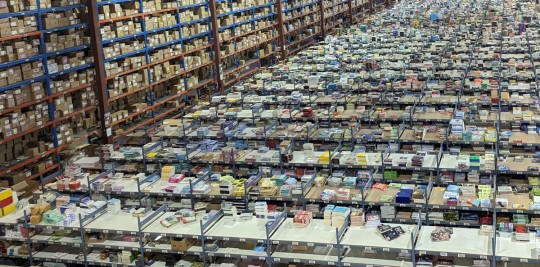
Next Tuesday (December 5), I'm at Flyleaf Books in Chapel Hill, NC, with my new solarpunk novel The Lost Cause, which 350.org's Bill McKibben called "The first great YIMBY novel: perceptive, scientifically sound, and extraordinarily hopeful."

It's that time of year again, when I round up all the books I reviewed for my newsletter in the previous year. I posted 21 reviews last year, covering 31 books (there are two series in there!). I also published three books of my own last year (two novels and one nonfiction). A busy year in books!
Every year, these roundups remind me that I did actually manager to get a lot of reading done, even if the list of extremely good books that I didn't read is much longer than the list of books I did read. I read many of these books while doing physiotherapy for my chronic pain, specifically as audiobooks I listened to on my underwater MP3 player while doing my daily laps at the public pool across the street from my house.
After many years of using generic Chinese waterproof MP3s players – whose quality steadily declined over a decade – I gave up and bought a brand-name player, a Shokz Openswim. So far, I have no complaints. Thanks to reader Abbas Halai for recommending this!
https://shokz.com/products/openswim
I load up this gadget with audiobook MP3s bought from Libro.fm, a fantastic, DRM-free alternative to Audible, which is both a monopolist and a prolific wage-thief with a documented history of stealing from writers:
https://pluralistic.net/2022/07/25/can-you-hear-me-now/#acx-ripoff
All right, enough with the process notes, on to the reviews!

GRAPHIC NOVELS
I. Shubiek Lubiek by Deena Mohamed

An intricate alternate history in which wishes are real, and must be refined from a kind of raw wish-stuff that has to be dug out of the earth. Naturally, this has been an important element of geopolitics and colonization, especially since the wish-stuff is concentrated in the global south, particularly Egypt, the setting for our tale. The framing device for the trilogy is the tale of three "first class" wishes: these are the most powerful wishes that civilians are allowed to use, the kind of thing you might use to cure cancer or reverse a crop-failure.
https://pluralistic.net/2023/01/11/your-wish/#is-my-command
II. Ducks by Kate Beaton
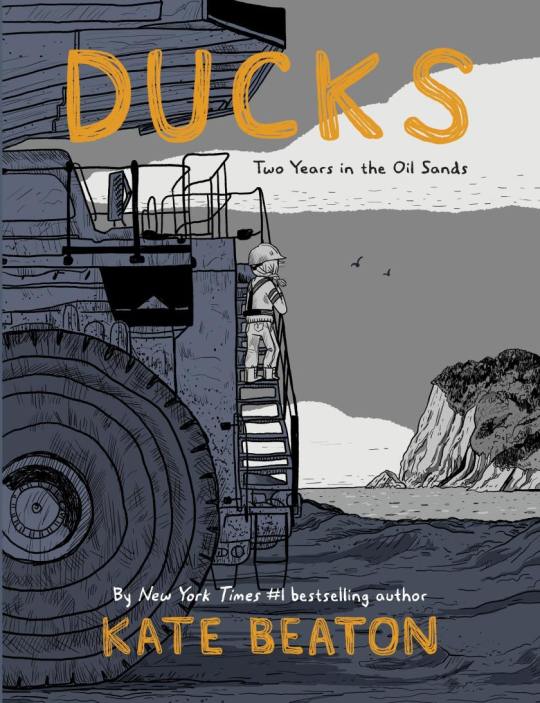
In 2005, Beaton was a newly minted art-school grad facing a crushing load of student debt, a debt she would never be able to manage in the crumbling, post-boom economy of Cape Breton, Nova Scotia. Like so many Maritimers, she left the home that meant everything for her to travel to Alberta, where the tar sands oil boom promised unmatched riches for anyone willing to take them. Beaton's memoir describes the following four years, as she works her way into a series of oil industry jobs in isolated company towns where men outnumber women 50:1 and where whole communities marinate in a literally toxic brew of carcinogens, misogyny, economic desperation and environmental degradation. The story that follows is – naturally – wrenching, but it is also subtle and ambivalent. Beaton finds camaraderie with – and empathy for – the people she works alongside, even amidst unimaginable, grinding workplace harassment that manifests in both obvious and glancing ways.
https://pluralistic.net/2023/01/14/hark-an-oilpatch/#kate-beaton
III. Justice Warriors by Matt Bors

Justice Warriors is what you'd get if you put Judge Dredd in a blender with Transmetropolitan and set it to chunky. The setup: the elites of a wasted, tormented world have retreated into Bubble City, beneath a hermetically sealed zone. Within Bubble City, everything is run according to the priorities of the descendants of the most internet-poisoned freaks of the modern internet, click- and clout-chasing mushminds full of corporate-washed platitudes about self-care, diversity and equity, wrapped around come-ons for sugary drinks and dubious dropshipper crapola. It's a cop buddy-story dreamed up by Very Online, very angry creators who live in a present-day world where reality is consistently stupider than satire.
https://pluralistic.net/2023/05/22/libras-assemble/#the-uz
IV. Roaming by Jillian Tamaki and Mariko Tamaki

The story of three young Canadian women meeting up for a getaway to New York City. Zoe and Dani are high-school best friends who haven't seen each other since they graduated and decamped for universities in different cities. Fiona is Dani's art-school classmate, a glamorous and cantankerous artist with an affected air of sophistication. It's a dizzying, beautifully wrought three-body problem as the three protagonists struggle with resentments and love, sex and insecurity. The relationships between Zoe, Dani and Fiona careen wildly from scene to scene and even panel to panel, propelled by sly graphic cues and fantastically understated dialog.
https://pluralistic.net/2023/09/11/as-canadian-as/#possible-under-the-circumstances

Like I said, this has been a good year in books for me, and it included three books of my own:
I. Red Team Blues (novel, Tor Books US, Head of Zeus UK)

Martin Hench is 67 years old, single, and successful in a career stretching back to the beginnings of Silicon Valley. He lives and roams California in a very comfortable fully-furnished touring bus, The Unsalted Hash, that he bought years ago from a fading rock star. He knows his way around good food and fine drink. He likes intelligent women, and they like him back often enough. Martin is a—contain your excitement—self-employed forensic accountant, a veteran of the long guerilla war between people who want to hide money, and people who want to find it. He knows computer hardware and software alike, including the ins and outs of high-end databases and the kinds of spreadsheets that are designed to conceal rather than reveal. He’s as comfortable with social media as people a quarter his age, and he’s a world-level expert on the kind of international money-laundering and shell-company chicanery used by Fortune 500 companies, mid-divorce billionaires, and international drug gangs alike. He also knows the Valley like the back of his hand, all the secret histories of charismatic company founders and Sand Hill Road VCs. Because he was there at all the beginnings. Now he’s been roped into a job that’s more dangerous than anything he’s ever agreed to before—and it will take every ounce of his skill to get out alive.
https://us.macmillan.com/books/9781250865847/red-team-blues
II. The Internet Con: How to Seize the Means of Computation (nonfiction, Verso)
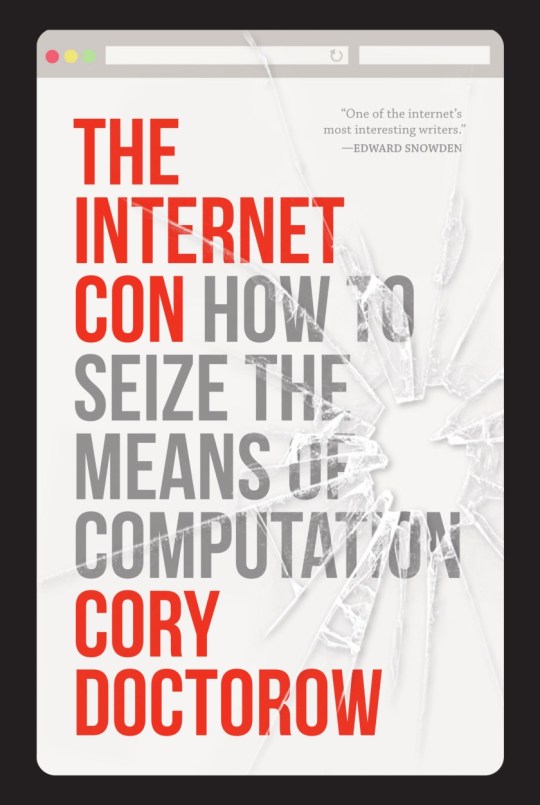
We can – we must – dismantle the tech platforms. We must to seize the means of computation by forcing Silicon Valley to do the thing it fears most: interoperate. Interoperability will tear down the walls between technologies, allowing users to leave platforms, remix their media, and reconfigure their devices without corporate permission. Interoperability is the only route to the rapid and enduring annihilation of the platforms. The Internet Con is the disassembly manual we need to take back our internet.
https://www.versobooks.com/products/3035-the-internet-con
III. The Lost Cause (novel, Tor Books US, Head of Zeus UK)
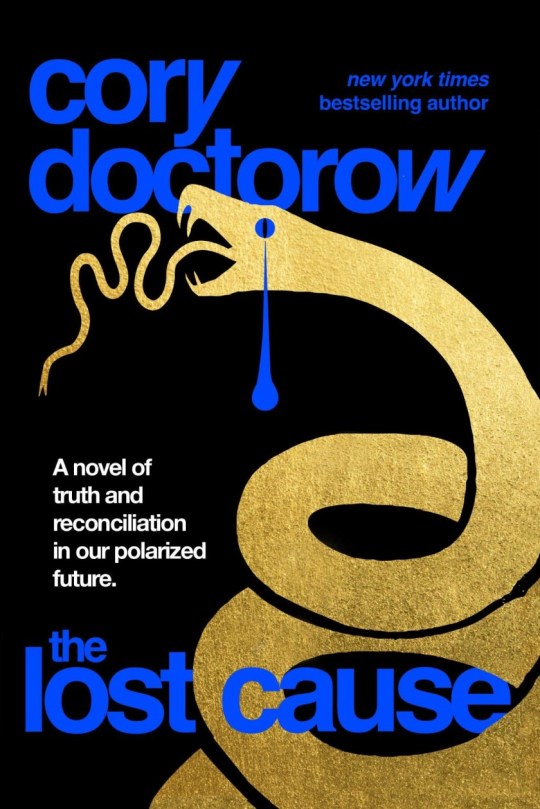
For young Americans a generation from now, climate change isn't controversial. It's just an overwhelming fact of life. And so are the great efforts to contain and mitigate it. Entire cities are being moved inland from the rising seas. Vast clean-energy projects are springing up everywhere. Disaster relief, the mitigation of floods and superstorms, has become a skill for which tens of millions of people are trained every year. The effort is global. It employs everyone who wants to work. Even when national politics oscillates back to right-wing leaders, the momentum is too great; these vast programs cannot be stopped in their tracks.
But there are still those Americans, mostly elderly, who cling to their red baseball caps, their grievances, their huge vehicles, their anger. To their "alternative" news sources that reassure them that their resentment is right and pure and that "climate change" is just a giant scam. And they're your grandfather, your uncle, your great-aunt. And they're not going anywhere. And they’re armed to the teeth. The Lost Cause asks: What do we do about people who cling to the belief that their own children are the enemy? When, in fact, they're often the elders that we love?
https://us.macmillan.com/books/9781250865939/the-lost-cause

I wrote nine books during lockdown, and there's plenty more to come. The next one is The Bezzle, a followup to Red Team Blues, which comes out in February:
https://us.macmillan.com/books/9781250865878/thebezzle
While you're waiting for that one, I hope the reviews above will help you connect with some excellent books. If you want more of my reviews, here's my annual roundup from 2022:
https://pluralistic.net/2022/12/01/bookishness/#2022-in-review
Here's my book reviews from 2021:
https://pluralistic.net/2021/12/08/required-ish-reading/#bibliography
And here's my book reviews from 2020:
https://pluralistic.net/2020/12/08/required-reading/#recommended-reading


It's EFF's Power Up Your Donation Week: this week, donations to the Electronic Frontier Foundation are matched 1:1, meaning your money goes twice as far. I've worked with EFF for 22 years now and I have always been - and remain - a major donor, because I've seen firsthand how effective, responsible and brilliant this organization is. Please join me in helping EFF continue its work!

If you'd like an essay-formatted version of this post to read or share, here's a link to it on pluralistic.net, my surveillance-free, ad-free, tracker-free blog:
https://pluralistic.net/2023/12/01/bookmaker/#2023-in-review
59 notes
·
View notes
Text
Sign the petition to demand the creation of a new international law requiring fast-fashion garments to come with a statement of the human cost and environmental harm caused by their creation.
We all know fast fashion is bad for the planet - slave labor, environmental waste, air and water pollution, and unsustainable practices are just a few of the ways they impact our planet, our health and our lives. To date, the fast fashion industry is the 2nd largest consumer of water and is single-handedly responsible for 10% of global carbon emissions (that's more than all international flights and maritime shipping across a year combined). Even the simple act of washing these clothes releases 500,000 tons of microfibers into the ocean each year - that's equal to 50,000 plastic bottles. Fast-fashion is the 3rd leading cause of the climate crises we face, yet is rarely addressed.
Knowing these stats is one thing, and understanding them is important. Being aware of them is somewhat informative. But as long as we keep turning a blind eye to the issue, the stats are only going to get worse, and nothing will change for the better. Ignoring the issue or brushing it under the rug won't help anything. So what if we could see the real-world damage done by each of the garments we buy?
In the same way that cigarette packets have shown the harm their products do to our bodies ("SMOKING KILLS", lung cancer visualizations, etc.), what if fast fashion manufacturers & retailers had to show the harm their products do to our planet?
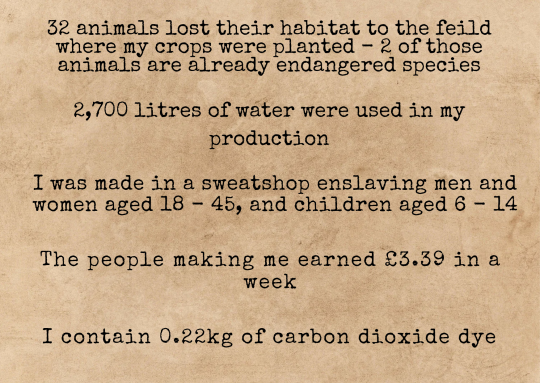
[Image ID: A type-writer font has been used on a brown craft paper background. The text reads: "32 animals lost their habitat to the field where my crops were planted - 2 of those animals are already endangered species. 2,700 litres of water were used in my production. I was made in a sweatshop enslaving men and women aged 16 - 45, and children aged 6 - 14. I contain 0.22kg of carbon dioxide dye." End ID.]
This is a mock-up of a label / statement for a single T-shirt, with researched statistics and educated estimates for the information I couldn't find a calculated answer for.
Now imagine labels / statements like this for every single piece of clothing: how many toxic chemicals are in those new jeans? How many litres of water did that shirt take to make? How many animals were skinned to make those cute fur-trimmed boots? How many children made that jumper? How many people were forcibly removed from their homes, so production companies could plant crops to grow the materials used in clothes manufacturing? How many families were evicted for no reason other than corporate greed? How many trees were cut down? How many animals were displaced or killed?
Would you really want to buy those items of clothing if the answers to those questions were staring you in the face?
If this information was stated in clear, accessible ways on both the website and the ticket on the actual garment, this would dramatically reduce the number of people buying fast fashion items. It would also reduce the profits being made by fast fashion companies, and could lead to many of them being forced to choose between changing and becoming sustainable, eco-froendly and ethical brands, or shutting down due to being boycotted.
Who would really want to knowingly buy things that are made by slaves, or which cost a family their home, or which contributed to deforestation? Who would continue to buy fast fashion items knowing this is the damage caused by them, when sustainable alternatives are an option?
Whether it's second-hand fashion at affordable prices, or investing more money in sustainable products which were made with high ethical standards and which cost more money due to the fact their price accounts for the time it took a person to make that item... we can say for certain that sustainable shopping is going to become much more popular if people know how important that change is. Sustainable items last much longer than fast-fashion items, which by design are created to self-destruct, as they are made to be worn a few times and then discarded in order to be replaced by the next trend's items - and as trends speed up, these items become weaker and weaker. This then leads to people spending more money in order to keep up with the newest trends, and to keep replacing clothes they throw out after a few washes.
In contrast, buying sustainable items which are designed to last years means people won't have to spend money on new clothes every few weeks, which means they'll ultimately save money in the long term and actually be able to afford those pricier items which will last much, much longer.
Now, despite the amount of harm the fast-fashion industry causes to people and the environment, the last thing we should be doing is getting angry at those who continue to buy them. Being the target of anger doesn't make large populations change their behaviour - even a cursory look through history books will tell us that much. Neither does being the target of resentment or blame.
But guilt? Shame? Those are two of the most powerful emotions to magnify when you want change to happen in waves.
And frankly, if people feel ashamed of buying something, or if buying something makes them feel guilty... they're going to stop buying it.
Those aren't the only emotions that should be felt, though. Because only feeling guilt and shame leads to feeling hopeless, scared, anxious and depressed. And we don't want that. No matter how bad things get... we don't want that.
The only other emotions to provoke are hope and pride.
If there's no hope for the future, how can anyone be expected to imagine a better one?
You wouldn't think it, what with all the climate crises and disasters we experience around the world and the total lack of commitment made by billionaires, multimillion-dollar companies and corporations and politicians.
But it's true. Scientists in Scotland have discovered bacteria which eat plastic and speed up the decomposition of it. ‘Ecocide’ is now punishable by law. Some countries within the EU are already close to meeting their 2030 goals years ahead of schedule! Thanks to scientists and small, individual changes made on a massive scale by ordinary people who are making small adjustments to our everyday choices, we can and are healing most of the ozone layer before 2050. That is something we should all feel incredibly proud of.
So imagine how much we could speed that process up if more people made those changes. Imagine how much sooner we could heal our planet if billions of people made those changes, rather than millions. Imagine how much sooner we could be seeing the effects of a healthier planet if fast fashion companies were forced to choose between going green and transparent, or closing altogether due to a lack of interest from consumers. Imagine the changes we could create if corporations made massive changes in a short amount of time, in order to save their own profits.
Imagine more labels like this, sitting alongside each other on every single piece of fast fashion clothing. A statement like this beneath every item of clothing on fast fashion websites, which transparently states the harm done.
If every single fast-fashion company and store had to display this on their clothing, on their racks, on their websites, and if there were legal punishments for those who tried to evade or lie... fashion would turn a lot greener very quickly. We'd start seeing more and more labels with "I'm made from 6 plastic bottles! I used to be a newspaper! I had 0 pesticides used on me in my production! I only contain natural dye made from berries, beans and sustainably grown flowers. I was made from apple skins and corn! The people who made me get to go home to their families every night, have days off and the adults made £150.35 each in 1 week! The animal who made the wool for me is free-range and well-cared for! I came from a small family farm, and was created with a closed-loop water system!”
That'd be a much better civilisation to shop in, don't you agree?
That is hope for the future.
That is motivation, which can fuel ordinary people to do extraordinary things and create changes they thought were impossible.
If you want to be a part of creating this change, sign the Change.org petition which demands the the creation and implementation of an international law which will require all fast-fashion products to be displayed with a statement which states the harm done to people and the planet by that garment being made & shipped.
#fast fashion#fashion#climate crisis#climate change#climate action#climate catastrophe#environmentalism#environment#environmetalists#enviromental#sustainability#sustainable#economy#ecofriendly#ecosystem#europe#earth#ecommerce#society#socialist#sociology#social justice#social media#slave labor#children#child labor#children's rights#environmental justice#petition#petitions
40 notes
·
View notes
Text
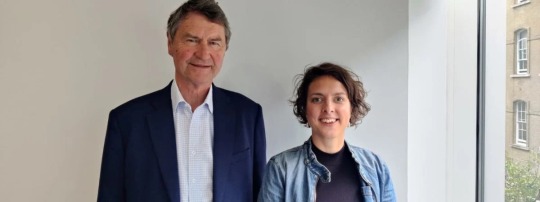
Vice Admiral Sir Timothy Laurence appointed Patron of the International Maritime Rescue Federation
Vice Admiral Sir Timothy Laurence, the husband of Her Royal Highness the Princess Royal, has been named the Patron of the International Maritime Rescue Federation (IMRF), the world’s leading organisation for developing and improving maritime search and rescue (SAR) capabilities.
He replaces Sir Efthimios Mitropoulos, the Secretary-General Emeritus of the International Maritime Organization (IMO), who stepped down earlier this year, having been in the role since 2012.
Sir Tim holds a distinguished career as part of the UK’s Royal Navy, serving from the early 1970s upon leaving the University of Durham before retiring in 2010. His strong interest and background in maritime led to him being appointed to the Governing Council of the UK’s Royal National Lifeboat Institution in 2004, then to the Trustee Board and Chairman of the Operations Committee in 2011. He later became Deputy Chairman of the RNLI Board and, on retirement from the Board in 2020, became a Vice President.
As Patron, Sir Tim will become a leading voice and advocate for the work of the IMRF and maritime SAR organisations around the world, which continues to play a critical role in protecting and saving lives at sea.
“It is an honour to be appointed the new Patron of the IMRF, and I look forward to working closely with the organisation, its members and SAR personnel worldwide to advance the cause of safety at sea,” Sir Tim said.
Speaking about the appointment, Jacob Tas, Chair of the IMRF, said, “I am delighted that Sir Tim Laurence has accepted our invitation to become the new Patron of the IMRF. His tenure at the UK’s Royal Navy and his dedication to public service means he will be a fantastic supporter of the IMRF’s global work and the critical importance of maritime SAR organisations globally.”
Caroline Jupe, Chief Executive Officer of the IMRF, said, “The IMRF and its membership continue to play a major role in the maritime SAR sector as we look to prevent loss of life in the world’s waters. I am thrilled that Sir Tim has agreed to join the IMRF community as our new Patron, and I’m excited to see how we can work together to bolster the maritime SAR sector, tackle critical issues facing the sector and advance key initiatives to improve the lives of those working in a challenging industry.”
In addition to its work providing guidance and best practice for SAR operations, the IMRF has also launched a number of critical initiatives to improve the wellness and efficiency of SAR personnel, including its #WomenInSAR campaign, its #SARyouOK? mental health initiative and its #FutureSAR climate change awareness campaign.
#yaaaay#a tim patronage#ffs charles just make him a working royal already#tim laurence#timothy laurence#tim does stuff#british royal family#brf#princess anne#princess royal
81 notes
·
View notes